AMD Launches Mobile Kaveri APUs
by Jarred Walton on June 4, 2014 12:01 AM ESTAMD Kaveri FX-7600P System/CPU Performance Preview
After the briefing, we were given a chance to benchmark a prototype Kaveri notebook for a few hours. That wasn't enough to run our full suite of laptop benchmarks, and battery testing in particular is something we couldn't perform. I did run some quick simulations of battery life; however, the prototype systems are optimized more for performance rather than power, so the results weren't really meaningful. We'll have to wait for retail laptops with Kaveri APUs before we can really see what sort of battery life to expect, but AMD claims there should be a decent jump in mobility compared to Richland.
The test systems were more of a proof of concept rather than anything you could actually sell. The keyboard was okay if a little mushy, but the touchpad in particular I found a bit lacking, and build quality was mediocre as well. The screens at least were good quality 1080p 15.6" touchscreen panels, and that was enough to get us benchmarking. I snapped a few pictures of the laptop that you can see above. In terms of other core specs, the laptop had 8GB of DDR3-1866 RAM and a Samsung M.2 256GB SSD.
For our purposes here, we're including the AMD Kaveri Prototype, AMD Trinity Prototype, and AMD Kabini Prototype laptops as a starting point. For retail laptops, we have the MSI GX60 with Richland A10-5750M APU (but only a single 8GB SO-DIMM, unfortunately), the Sony VAIO Pro 13 (i5-4200U), and the Acer V7-482PG (i7-4500U + GT 750M). The Acer is the only laptop equipped with a discrete GPU, so we wanted to see how Kaveri stacks up against such a system. You can compare additional results against Kaveri in Mobile Bench, of course.
Again, these numbers are only preliminary – the drivers for the GPU were slightly older (without Mantle support enabled yet), and there were occasions of odd behavior where other editors had scores that didn't match up with our results until after a reboot. We were not able to run each benchmark multiple times, so most of these results are from a single run. AMD is keen to talk about the GPU improvements with Kaveri, but I also wanted to see what has happened on the CPU side, so we'll start with our CPU/system benchmarks.
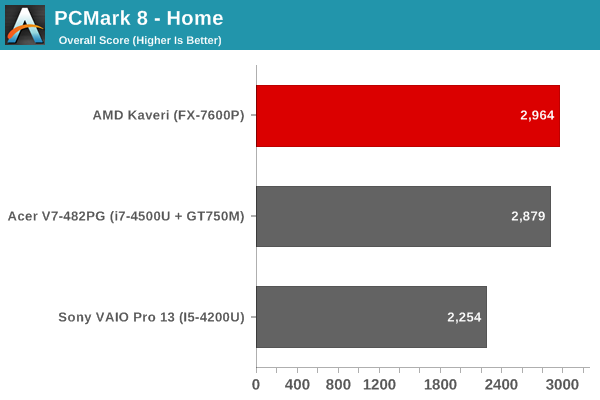
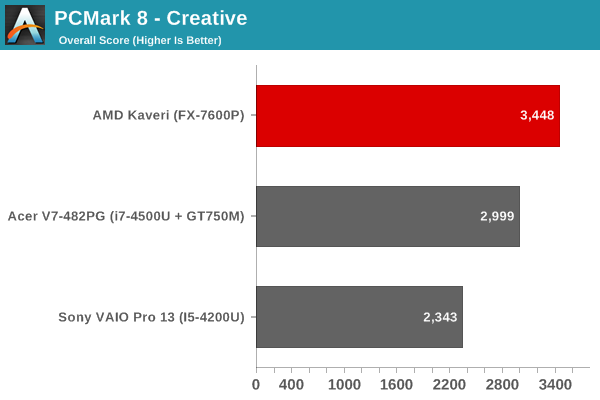

We don't have results for PCMark 8 for many of the systems, and the VAIO Pro 13 seems to be underperforming for some reason, but otherwise we get a pretty good idea of where things fall in terms of overall performance. Note that PCMark 8 is now OpenCL accelerated, which can improve performance quite a bit on AMD APUs. The result is that AMD actually takes the lead in the Home and Creative suites, but without more time benchmarking the system I wouldn't try to draw too many conclusions. Storage subsystem performance can still have an enormous impact on PCMark results, and the V7-482PG has to get by with an SSD caching solution. The VAIO Pro 13 on the other hand just seems to score a bit lower than I'd expect, so again take these scores with a grain of salt.
Moving on to other benchmarks, I also ran PCMark 7 as it doesn't have any OpenCL acceleration and will provide a better view of traditional application performance. Hopefully we'll continue to see improvements in the use of OpenCL (GPU) acceleration and over time PCMark 8 scores will be more indicative of real-world performance, but right now there are plenty of situations where having a GPU does very little for performance.

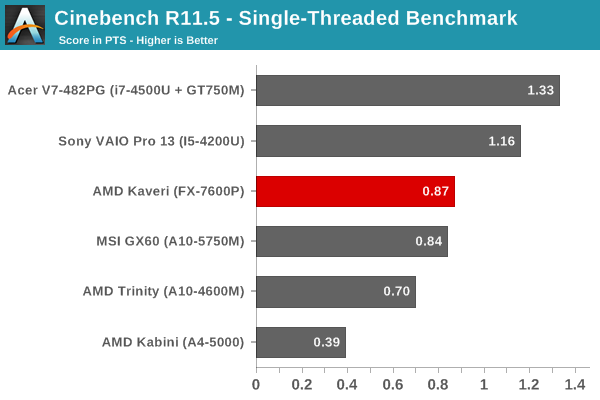
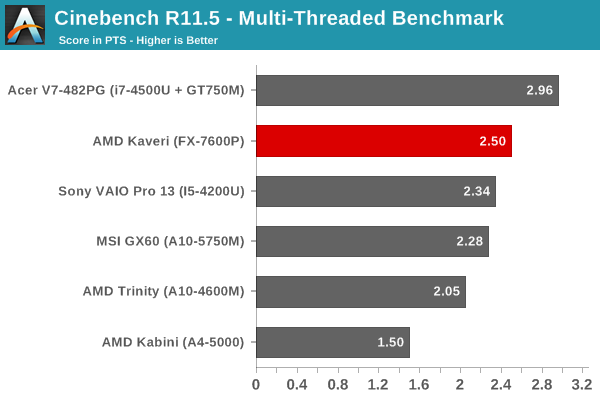
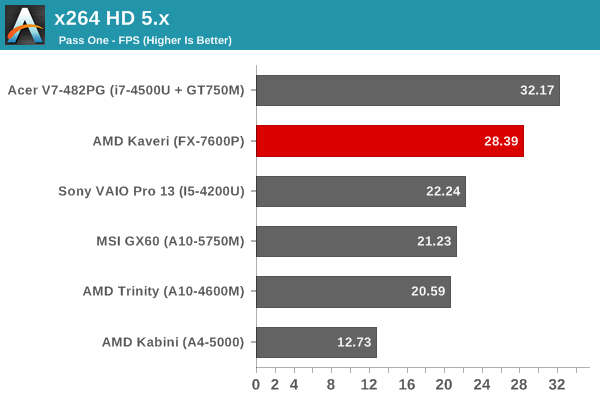
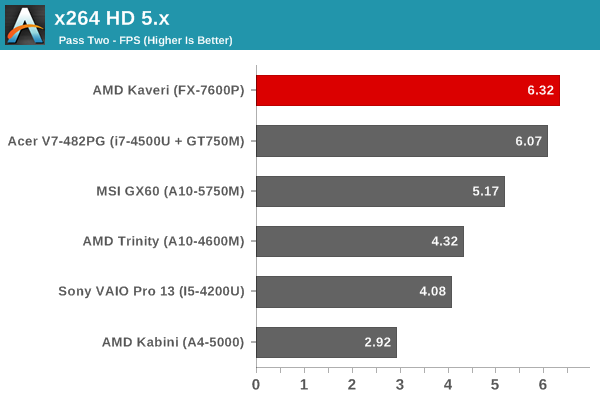
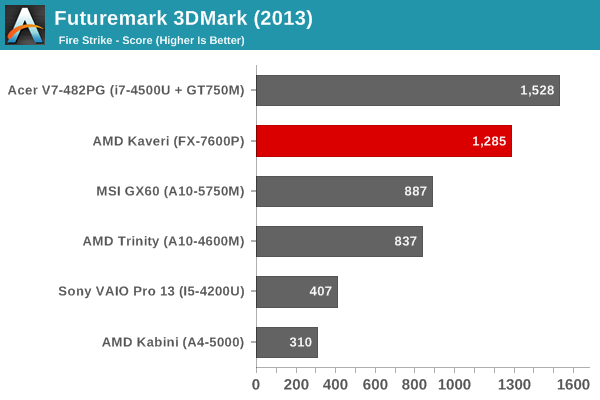
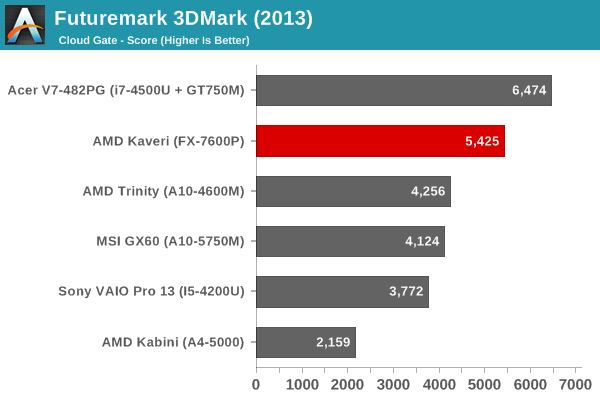

Somewhat surprisingly, Kaveri actually takes the lead in the very demanding second pass of the x264 HD 5.0 encoding test. Granted, we're looking at a 35W APU vs. 15W ULV CPU, and Intel's 37W quad-core parts would certainly retake the lead (and cost quite a bit more), but at least Kaveri is showing some real improvements over Richland in these tests. As noted above, PCMark 7 doesn't have any OpenCL optimizations so the gap between AMD and Intel is a bit wider.
Moving to the 3DMark results, Kaveri shows an impressive increase in performance over the Trinity/Richland GPU, which is expected. Intel's iGPU – particularly in the ULV system shown here – just doesn't stand a chance. While we are potentially TDP limited for the ULV Intel parts in graphics tests, my experience is that 3DMark hits the GPU much more than the CPU, so the GPU gets the lion's share of the TDP. I'll try to run some tests on other Haswell systems using the iGPU to verify the above results, but outside of the HD 5000 and Iris parts, I wouldn't expect Intel's iGPU to be too much faster than what we're seeing here.
Overall, an Intel CPU with a discrete GPU is still faster than Kaveri in most areas, and a quad-core i7-4702QM would really distance itself from AMD's Kaveri…but the quad-core i7 CPUs tend to start at around $350, so there's not much point in discussing that comparison. My personal feeling is that unless you're really pushing a laptop hard, most of the modern CPUs/APUs are plenty fast. I wouldn't want a Kabini APU, but Trinity/Richland, Ivy Bridge, Kaveri, and Haswell are all going to be fine for everyday use.
The more important element for me with a laptop (or desktop) is that I simply can't stand using conventional hard drives for the primary storage device any longer. Given the choice between an AMD Kaveri APU with a 256GB SSD (the Crucial MX100 is sure looking nice!) and pretty much any other laptop that has pure HDD storage, it's a no brainer for me. In fact, laptop manufacturers would do their customers a great service if they took the cost savings of AMD's APU vs. Intel's CPU and put that into a decent SSD solution rather than chasing the lowest possible price!


_thumb.jpg)
_thumb.jpg)
_thumb.jpg)
_thumb.jpg)
_thumb.jpg)








125 Comments
View All Comments
beggerking@yahoo.com - Wednesday, June 4, 2014 - link
icrap and affordable? what a joke! loldon't forget outdated low res screen, no pen input, no touch screen, and still more expensive.
Surface Pro is much better and much more affordable.
Galatian - Wednesday, June 4, 2014 - link
Exactly how is the 13" and 15" rMBP screen outdated and low res?Oh and: not everybody shopping for a notebook needs a touch display nor pen input. I even give you a reason why the 12" Surface 3 will not replace either notebooks or tablets: 750g.
nerd1 - Wednesday, June 4, 2014 - link
1st gen iPad 3G weighed 730gr and everyone said it's as light as a feather.Oh, and macbook still looks and weighs exactly same since then.
Galatian - Wednesday, June 4, 2014 - link
Your point? They are light now. I owned the 1st gen iPad and it was way to heavy to comfortably hold in my hands to read. I since switched to the iPad mini for its lightness and small form factor, nothing the Surface can provide me with. So I still tuck along my notebook to write stuff and use the iPad for media consumption. The surface simply doesn't work for me, but your mileage might vary. Just don't make it sound it's the holy grail that truly combines both tablets and notebooks, because it isn't. At least not for all.Morawka - Wednesday, June 4, 2014 - link
well for one it's not a IPS Screen, and 2, it's a low res panelGalatian - Wednesday, June 4, 2014 - link
The iPad mini with retina? You need to check your facts.ShieTar - Wednesday, June 4, 2014 - link
The 35W AMD APU is giving you about 75% of the mobile gaming performance that you get with a 15W Intel CPU + 50W nVidia GPU; but over 200% of the 15W Intel APU performance. That's a very decent result in my opinion. Sure it's slower as a pure CPU, but I don't think it will hit its 35W TDP limit when the GPU part is dormant, either.Another interesting comparison might have been to see how FX-7600P fairs against something like an i7-4558U, i.e. an Intel APU with a ~30W TDP and an Iris GPU.
Roland00Address - Wednesday, June 4, 2014 - link
While I agree with you perfectly on what you said, I want to bring up another point. The gt750m is a kepler part with 384 stream processors (2 SMX). We now have maxwell on the market and maxwell is very good. With maxwell you get 640 stream processors (5 SMM, 1 SMM is roughly 90% of an SMX) in roughly the same tdp that as the gt750m. Thus nvidia+intel is able to get a large increase in number of calculation units in roughly the same form factor.So in sum AMD is able compete with intel and intel+nvidia only on price and/or time to market. Intel and Intel+Nvidia can meet AMD on graphic efficiency, form factors, and Intel is faster in cpu tasks. Sadly I wish AMD was doing better than they are, not because AMD is bad but I want more competition and more competition is always good for the end user. Problem is AMD may bring their B+ game often but when you have Intel and Nvidia as competitors you need to bring your A+ game to win for your competitors are just as talented as you are and they have far more design resources due to greater revenue and cash on hand which means more money spent on engineers.
Krysto - Wednesday, June 4, 2014 - link
Intel cheats with Turbo-Boost, though, being able to win 5-minute benchmarks because of Turbo-Boost, while also claiming long battery life because Turbo-Boost barely gets any use, so the chip is actually running at lower performance than advertised in the long term.Galatian - Wednesday, June 4, 2014 - link
And AMD doesn't turbo? o.O